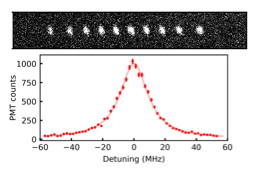The unstable radium nucleus is appealing for probing new physics due to its high mass, octupole deformation and energy level structure. Ion traps, with long hold times and low particle numbers, are excellent for work with radioactive species, such as radium and radium-based molecular ions, where low activity, and hence low total numbers, is desirable. We address the challenges associated with the lack of stable isotopes in a table-top experiment with a low-activity (∼ 10 μCi) source where we laser-cool radium ions to form radium Wigner crystals. With a laser-cooled radium ion we measured the 7p 2Po1/2 state’s branching fractions to the ground state, 7s 2S1/2, and a metastable excited state, 6d 2D3/2, to be p = 0.9104(7) and 0.0896(7), respectively. With a nearby tellurium reference line we measured the 7s 2S1/2 → 7p 2Po1/2 transition frequency, 640.09663(6) THz.
